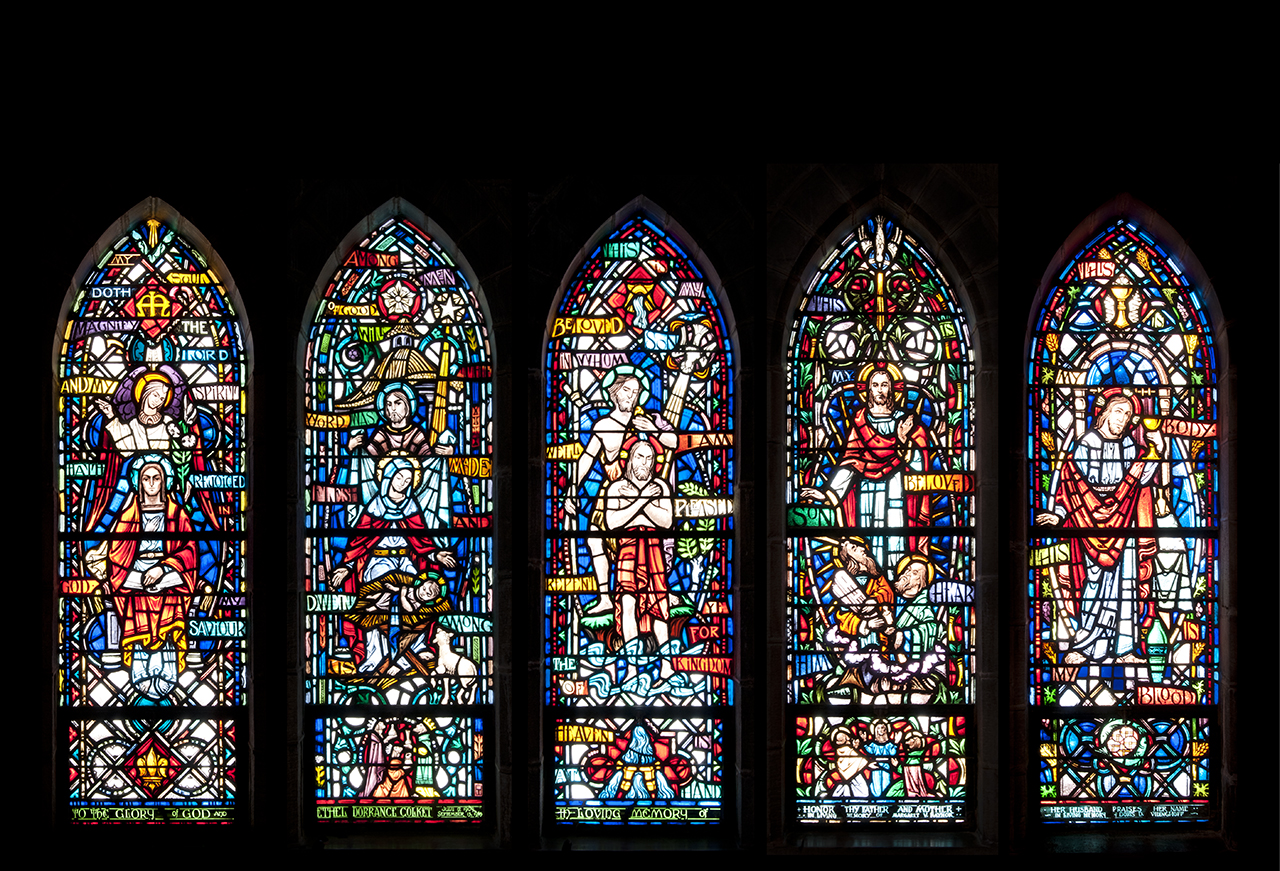The nave aisle windows of Christ Church Ithan were designed and developed by the Willet Stained Glass Studios of Philadelphia, depicting key events in the life of Jesus.
The chancel windows were made by a French design company and illustrate the story of St Martin, after whom the church was originally named.
The four-lancet West Window, located at the rear of the church, was designed and executed by the Willet Studio. It illustrates the history of the Church, and the Anglican Communion in particular. The seal of the latter appears in the tracery.
Across the center of the window are four larger figures. The first of these is St. Paul the great missionary that legend tells traveled even as far as England with news of the new religion. He holds an open book and the "sword of the spirit."
Next is St. Joseph of Arimathea, who buried the body of Jesus in his new tomb. He holds a flowering staff, the Glastonbury thorn. Next is St. Alban, the Roman soldier who was the first Christian martyr in Britain. Fourth is St. Augustine who was sent by St. Gregory the Great to England to find that Queen Bertha was a Christian. Her husband King Ethelburt was baptized and gave the land upon which Canterbury Cathedral now stands.
The Annunciation
The angel Gabriel stands behind Mary, holding a lily.
Above is Mary's monogram and below is a fleur-de-lys, symbol of her purity.
The Nativity
The Holy Family are gathered in the stable under the rays of the Star.
The three wise men are shown in the section at the bottom.
The symbol at the top is the Christmas rose.
The Baptism
The Holy Spirit appears in the form of a dove as John baptizes Jesus.
The escallop shell is the symbol at the top.
In the lower section is a font with flowing water.
The Transfiguration
Jesus appears on the Mount of Transfiguration, flanked by Moses holding the Tablets of the Law, and Elijah with a scroll.
The Spirit dove is at the apex of the window.
The three small figures at the bottom are Peter, James and John who witnessed the scene from below.
The Last Supper
This window tells the story of the Last Supper by a single figure of Jesus holding the chalice.
The symbol at the top is a chalice and host.
At the bottom are the five loaves and two fish, the boy's lunch which Jesus multiplied to feed five thousand people.
The Crucifixion
Jesus hangs on the cross.
Above is the symbol of the Lamb of God, who takes away the sins of the world.
At the bottom is a pillar and scourges.
The Resurrection
The Resurrection of Christ is told by the angel to the women at the tomb.
Above is the butterfly, symbolizing universal life after death. The caterpillar represents life on earth. The seeming death in the cocoon is the grave. Afterwards the butterfly emerges to fly on bright wings to heaven.
The phoenix at the bottom is a mythological bird of which the ancients believed that, instead of dying, she set fire to her nest and rose rejuvenated from the flames - a universal resurrection symbol.
The Ascension
Christ the King leaves the earth and ascends to heaven, where he will reign surrounded by stars and angels.
At the bottom, the musical instruments and the censer (a vessel for burning incense) symbolize prayer and praise.
The Great Commission
Christ stands at the center, superimposed on a grape vine: "I am the vine, ye are the branches." At the base is chi rho (XP), the sacred monogram for Jesus Christ. On the branches in circular medallions are the symbols of the Apostles. Peter, James the Greater, John, Andrew, Philip, Bartholomew, Thomas, James the Less, Matthew, Jude and Simon. In place of Judas, Matthias was used.
The inscription is the Great Commission Jesus gave to his Apostles, to go into the world and preach the Gospel and baptize.
Above him are the font of Baptism, the chalice and host of Communion, and two doves approaching a chalice, representing Confirmation. Nearer the bottom are a stole and a book for Holy Orders, and an olive branch and an oil stock for Holy Unction.
Below these are entwined lamps and rings surmounted by a cross for marriage and crossed keys and scourges for penance. At the apex of the window is the Holy Spirit dove.
The Sea Of Galilee
This window shows the disciples in a boat on the Sea of Galilee. As a storm brew up, they realized they were too far from shore, and were becoming increasingly frightened.
Seeing a figure walking on the ater, they think it's a ghost and that they're about to die.
The figure speaks, and they realize it is Jesus.
"It is I, be not afraid", is the inscription on the window.
Below it is St Christopher, the patron saint of travelers.
This window is dedicated to the memory of James Kent Willing and Margaretta Anspach Willing, who passed away in 1955.
The East Window, located behind the altar, features St. Martin, after whom the church was originally named. The apex displays the acronym IHS (Iesus Hominum Salvator or In Hoc Signo), below which two angels face each other.
From top to bottom on the Gospel side (left), St Martin is shown being enrolled in the Roman army, then Christ appearing to him, then being ordained by Hilary.
On the Epistle side (right), he is shown in his cell at Poitiers, then raising the widows son, then with the Bishop of Tours. The bottom center lancet shows St Martin and the beggar.
The center pane showed St Martin until 2007, when it was replaced by the image of Christ. The original St Martin's pane now features in the small chapel located in Ithan Hall.













